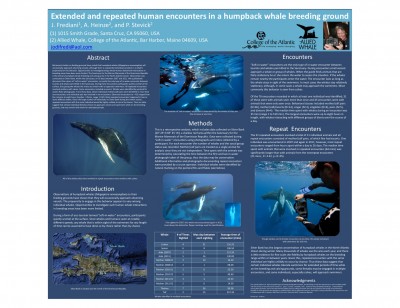- Welcome to Conscious Breath Adventures
International Marine Mammal Conference Delivers - Swim with whales, Silver Bank Dominican Republic | Conscious Breath Adventures
A special report on the 19th Biennial Society of Marine Mammalogy Conference in Tampa, Florida by Jodi Frediani.
Wow, a week of total immersion with whales, porpoises, dolphins, manatees, dugongs, sea lions, seals, sea otters and polar bears without getting wet! I just returned from the 19th Biennial (my first) Society of Marine Mammalogy Conference in Tampa, Florida. What an amazing week! Nearly 2000 people, including many of the top marine mammal researchers from around the world, along with students, educators, naturalists, and boat captains, came together to share the latest in scientific studies, seriously network and have a jolly good time. The theme for this year’s conference though was less than jolly, “Cumulative effects of threats to marine mammals: Challenges to animals, scientists, and managers.”
I presented my first ever poster on “Extended and Repeated Human Encounters in a Humpback Whale Breeding Ground.” Put into lay terms, the poster was about the ‘friendly humpbacks’ we are privileged to swim with out on the Silver Bank. My limited data set (with help from Capt. Gene Flipse of Conscious Breath Adventures) showed, in part, that guests swam with some mother/calf pairs on four or five different days, with average encounters up to two hours, and with one mother on 2 different years. Of course, mine was one of over 600 posters covering a vast range of topics. Here’s a small sampling. “Long distance Movement Patterns of Humpback Whales”, “Evidence of shark attacks on Atlantic spotted dolphins off Bimini, The Bahamas”, “Humpback whales wintering off Puerto Rico”, “Observation of a humpback whale birth in the coastal waters of Sainte Marie Island, Madagascar”, “Description and classification of ‘social’ sounds produced by humpback whales during the feeding season”, plus posters on just about everything marine mammal related.

In particular, session topics ranged from historical Soviet whaling (which under-reported 180,000 catches), impacts of fishing, noise, PCBs and other contaminants, ship strikes, how to differentiate between lethal and non-lethal injuries, risks of entanglement, design of marine protected areas, new understanding of cetacean communication and underwater behavior, humpback song as a cooperative strategy between males, tagging results, methodologies, and hazards, effects of climate change, singing female bowhead whales, and so much more.
A video night served up an eclectic offering including views from a bottom feeding humpback critter cam, manatee rescue, special tracking simulations of what humpbacks do underwater, and mid-week, the evening activity was a forum on the Gulf Oil Spill. With hardly enough time for sleep, some folks still managed to get to the zoo to see manatees, while others took their own side-trips after the conference to swim with manatees at Crystal River.

I am pleased to say, that the Silver Bank soft-in-water encounter program seems to be the best-regulated swim program anywhere. That is one reason I return season after season.
Sunday night set the social stage for the week ahead with an icebreaker at the Florida Aquarium, complete with sharks, sea horses, curious sting-rays in the touch tank, and an underwater mermaid. Of course, food and drink flowed freely as did lively conversation and music from a band in the courtyard. Closing night featured an amazing banquet. Again, food, drink and good conversation ruled the evening, though a band rocked out for dancers who twirled across the dance floor with abandon.
Personal highlights for me included meeting the wonderful folks from the Dominican Republic engaged in humpback research and tourism, as well as humpback enthusiasts from Newfoundland, Madagascar and the Stellwagen Bank off the coast of Massachusetts. I still need to review my notes and abstracts to absorb all the information presented. And I most certainly look forward to the 20th Biennial to be held in 2013 in Dunedin, New Zealand. Hope to see some of you there!